New to Florida and lamenting the low maintenance lush green lawn you left behind? HOA breathing down your neck to fix your problem areas? You’re not alone. Growing grass in Florida is not like growing grass in many other parts of the country. Keeping grass healthy, green, and weed-free here requires quite a bit of strategy. To start with the basics, proper fertiliziation and irrigation timing and quantity are criticial to a healthy green lawn.
Irrigation:
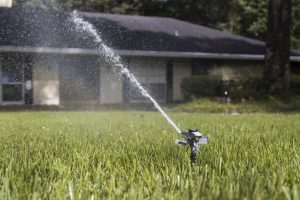
One common lawn care mistake homeowners often make is overwatering. UF/IFAS recommends applying ½ to ¾ of an inch of water each time you irrigate. Less leads to shallow roots, and more keeps the root system saturated with water, which is harmful to the lawn because it can cause roots to suffocate or lead to fungal problems and disease. Too much also wastes water and creates runoff as the grass can only take up so much water at a time.
The recommendation for how frequently you irrigate is based on season, the amount of sun or shade and grass species. With regular weekly rainfall, irrigation can be completely turned off in most cases, and during periods with little to no rain 1-2x per week is enough to keep your yard happy. The best time for lawn irrigation is in the early morning hours just before sunrise. Watering during the day wastes water to evaporation. Watering in late afternoon or evening may be detrimental as grass won’t have time to dry off before dark which can accelerate fungal problems and disease occurrence.
Fertilization:
Lawns can benefit greatly from fertilization but can also be damaged or killed by applying too much fertilizer or applying fertilizer at the wrong time of year. Only fertilize during your lawn’s growing season. Dormancy for warm season turfgrasses such as St. Augustinegrass, zoysiagrass and bahiagrass begins in mid-October and lasts through early April in North Florida. If you fertilize while the grass isn’t growing, your grass won’t absorb the nutrients and they could potentially leach into nearby water bodies. Another time to avoid fertilizing is if heavy rains are likely within 24 hours. Storms or flooding will wash away fertilizer before your lawn has a chance to use it. Applying too much fertilizer can burn a healthy lawn. The excess salts in the fertilizer build up and draw moisture away from the roots, drying out and damaging the turf. Overfertilizing can also trigger excessive growth which aggravates pest problems.
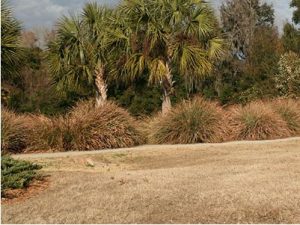
Dormancy:
All of our warm season turfgrass species go into some degree of dormancy during the winter months, slowing their growth down. They may or may not stay green. This is a natural cycle, regardless of where you live in the state. In North Florida, lawns may stay green or may turn brown, either of which can be normal. This also varies by species, so you may notice your grass going brown when your neighbor’s still looks perfectly normal. Would you like your lawn to look green for the winter? Try overseeding. It’s when you plant a temporary grass to provide a green lawn all winter. Ryegrass is popular for overseeding because of its fast growth and low cost. Sow the seed once daytime highs have fallen to the low to mid 70s. Grasses used for overseeding will die off as temperatures rise in the spring.
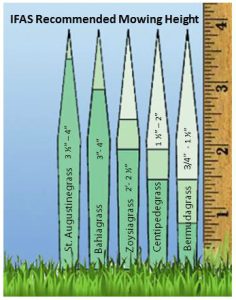
Mowing Height:
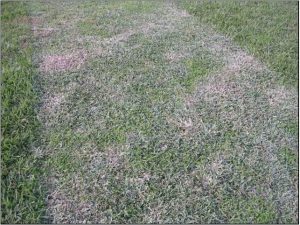
Photo by: L. Trenholm, UF/IFAS
Mowing height is another often overlooked piece of the puzzle. Each species of grass has its own researched and recommended mowing height for optimal health. If you mow grass too short, it can injure it, stress it out, and invite weeds to come in. To ensure your grass is being mowed at the correct height, first determine the species you are growing. Adjust cutting height by setting the mower on a driveway or sidewalk and using a ruler to measure the distance between the ground and the blade. Set it at the highest recommended setting for your species.
Dead patches:
Sometimes the entire lawn isn’t afflicted with a problem, but dead spots start to appear and grow with time. When there are dead areas in your lawn, it’s easy to repair them yourself by seeding, resodding or planting plugs. It’s imperative that before you start repairs you determine what killed these areas otherwise your effort might be for naught. Check your irrigation system for missed or overwatered areas, and look for other causes like insects or disease.
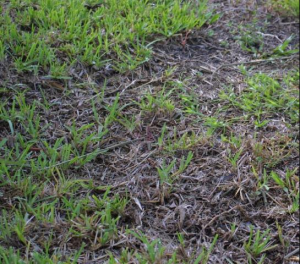
If you suspect insects or disease, before treating with chemicals or installing new grass, ask your local Extension Office for help determining exactly what you’re dealing with. Take several photos of the lawn from afar as well as close up and from a distance of 3-4′. Cut a sample about 8-10″ square from the edge of the dead area, being sure to include the top few inches of soil including roots, along with both the still green grass and the not so green grass. Bring it in so that it can be put under a miscroscope where it will be easier to determine the exact problem.
Dogs:
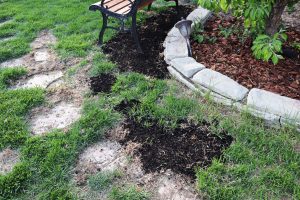
Dogs can be wonderful companions and fun playmates, but they can also wreak havoc on lawns.
If the dog runs in the same pattern every day the turf will suffer, and weeds may move in. This is especially problematic with large dogs and in shady areas where grass is naturally going to struggle to grow. Some species of grass are more tolerant of high traffic and wear and tear than others; however, in our sandy soils no grass will stand up to the heaviest of traffic. If bald patches pop up where your pup likes to run, consider putting down a paver, mulch, or pebble pathway in that area.
Also, when the dog uses the same spot to pee on the lawn over and over you may start to see what is commonly called “dog spot”. The urine is providing the lawn with a big dose of soluble nitrogen, so you can see some injury to the turf. Dog spot looks like a yellow circle in the grass. Dead spots from high traffic and animal waste can quickly ruin a green lawn. In fact, pet waste, urine especially, is a major culprit of lawn damage from dogs so if having a perfectly manicured lawn is your goal, take your dog to the park for a walk and exercise rather than allowing them to run free in the yard.

Photo by: Marco Schiavon, UF/IFAS
Types:
Doing everything right? It may just come down to your selected grass! For example, some cultivars of St Augustine, such as Citra Blue, have a literal blueish hue to them. If you are installing plugs or patching in sod into an existing lawn be sure to match the varieties or you may see a noticeable difference in color.
Overall, growing perfect grass can be a significant challenge for many Florida homeowners but by following the best management practices of irrigating efficiently, fertilizing appropriately and mowing at the correct height it is possible to reach your goals. Some people give up on the picture perfect lawn idea and decide to mow what’s green while others focus on reducing their high maintenance turf areas by replacing sections of the landscape with Florida-Friendly plant beds. Whichever route you choose, the Extension Office can help!
 4
4
